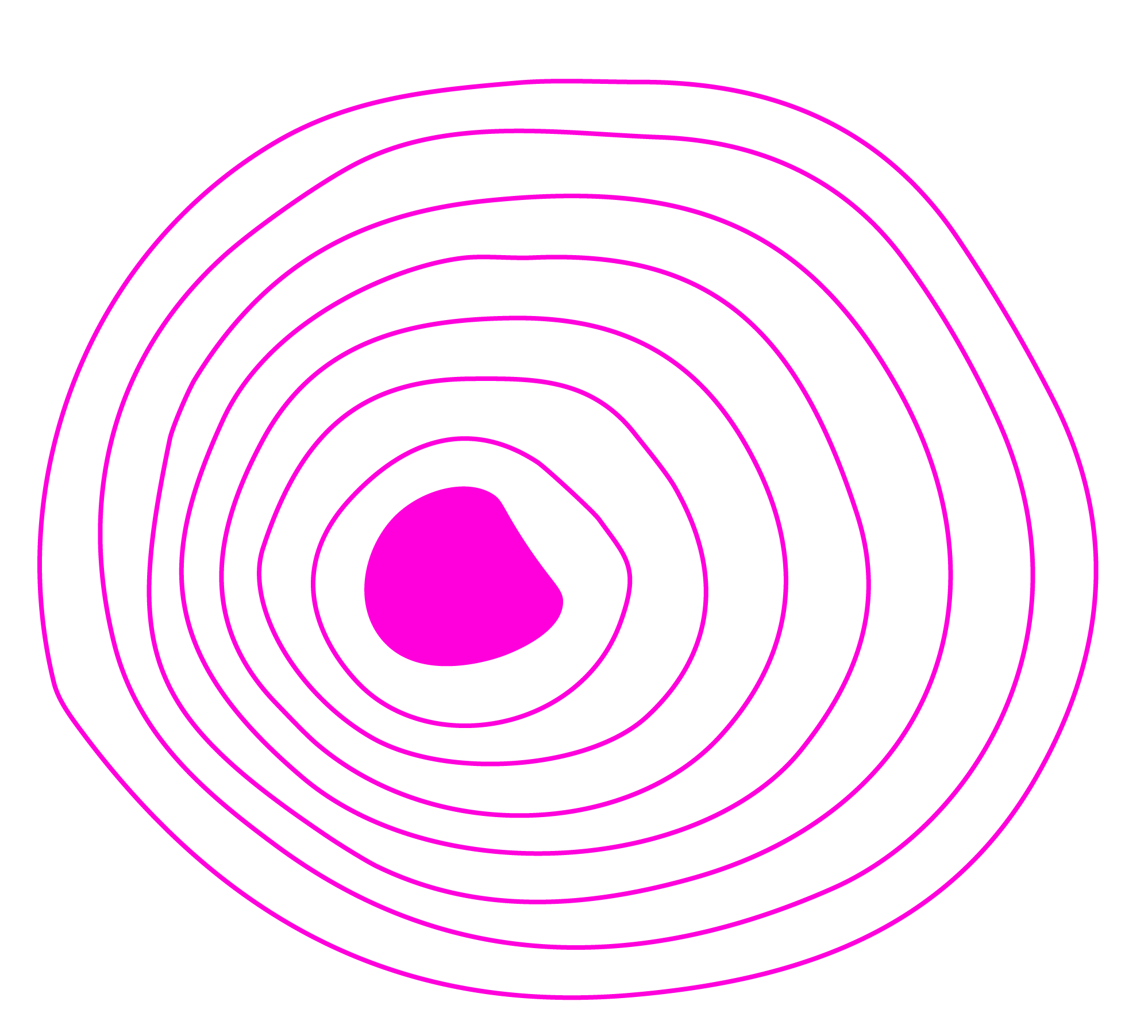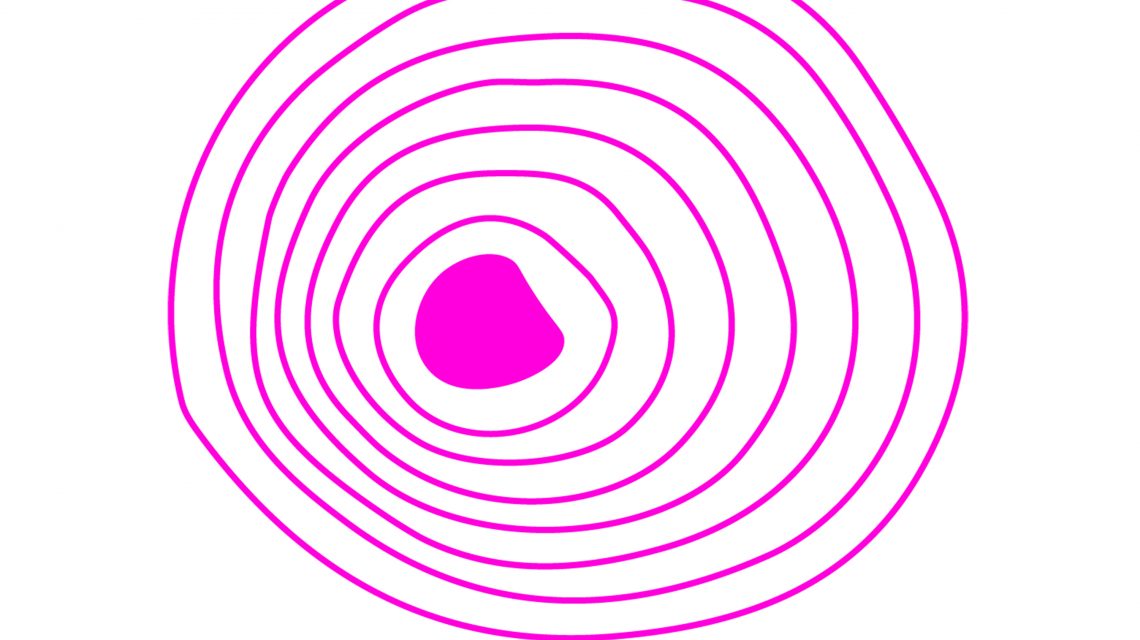Listen to podcast here on the Simple Landing page: https://share.transistor.fm/s/4ae3f02b
You can also directly download the mp3 file here: https://media.transistor.fm/72c1084f.mp3
Introduction:
TANYA’S VOICE:
Welcome to Nordic By Nature, a feature length podcast on ecology today inspired by the Norwegian Philosopher Arne Naess, who coined the term Deep Ecology. In this episode, ON ART you will hear the voices of two Norwegian artists, Catrine Gangstø and Laila Kolostyák. Catrine and Laila are committed to using ART as a meeting point for engaging the local community in thinking about equity, identity and our inner and outer natural worlds.
But first you will hear a few words from my colleague Ajay Rastogi, at the Foundation for the Contemplation of Nature. Ajay works closely with the women of Majkhali village in foothills of the Himalayas, in Uttarakhand, India. He set up the Vrikshalaya Centre there to be a meeting place and knowledge hub for the villagers and other communities in the Himalayan lowlands, as well as visitors and homestay guests interested in learning about more meaningful forms of sustainability.
Catrine Gangstø is the founder of the Peace Painting Foundation, that runs painting workshops for children, youth and adults all over the world, including war zones. Through her idea of Painting for Peace, Catrine has engaged over 3,000 workshop participants and many more through travelling exhibitions of their work. Catrine has proven that painting can be a safe space for sharing difficult experiences and emotions as well as a way to communicate hopes and desires for peace in the world.
Then we hear from Laila Kolostyák, a visual artist who works with snow and ice. Laila and her colleagues have engaged a whole generation of young people in creating and enjoying outdoor snow and ice experiences that culminates in the Borealis festival in Alta, which lies 375 km north of the Arctic Circle.
I hope you have time to sit back and enjoy listening!
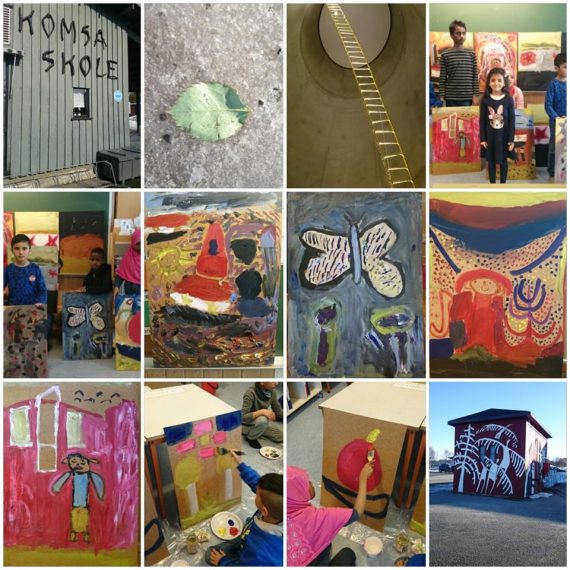
Peace paintings from Norway
AJAY: My name is Ajay Rastogi, and I’m joining from the central Himalayan region of Uttarakhand state in India.
It’s a lovely sunny morning and we have the mountain views of the high Himalayas in a very spectacular way. And that reminds me of the work of Katrina and Laila, as they do in Norway and all across the world, with the children as well as with all age groups, inspiring the people to connect with the art.
It’s a bit of a concern that art is increasingly thought of as something which is only about creativity and not as something which fills us with joy or something that we need to do as a part of our daily schedules are something that we need to connect with in a deeper way. As a community because somehow the distinction of work what should be there vs. what is leisure is somehow the art has shifted to the world of leisure whereas what we feel is that art and innovation and creativity was a part of our every walk of life.
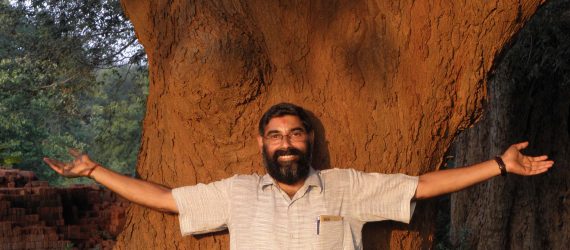
Ajay Rastogi, Founder of the Foundation for the Contemplation of Nature.
We did it in food and we did it with clothing. We did it with the shelter. We were very deeply connected in how we can have a community deeply connected with the landscape drawing resources from the landscape and making them artistically feasible for us to enjoy. And in a very communitarian way. Somehow, we feel that it’s the art which brings a lot of cooperation and collaboration. Art is also the measure of expression when we create works of art with natural Lord and in nature. Then I think we are definitely also a lot of harmony in more leaning. So there is a considerable amount of happiness and joy.
So, I think engineers can create art. Doctors can create art. Lawyers can create art financial people can create art. Art also creates us. We don’t just create the art. And I think that’s where we get in deeper in connection with ourselves with our bodies with our minds without emotions and we feel that empathetic connect with the community at large.
—————————
CATRINE INTRO
SOUND: Skype ringing.
Catrine: My name is Catrine Gangstø, and I have grown up in the northern part of Norway. and I am working with peace painting. It’s an Equality Project for Children and Youth. We started in to 2007, locally, but very soon it became international because we had grants from the foreign departments to try out the way of working with children and youth in other countries.
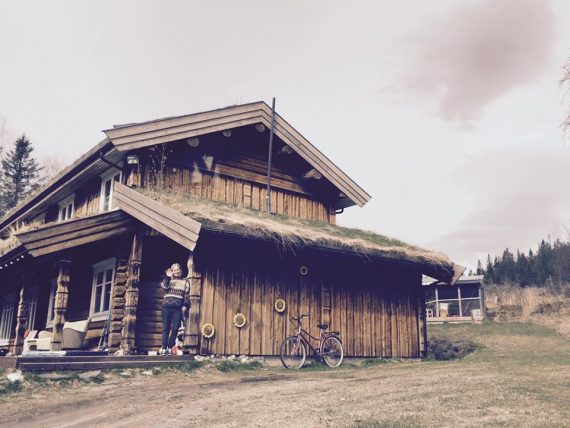
Catrine on holiday in Bindalen, Norway
It’s a lot of years since they had the idea in using colours as the main platform when we work with equality among children and youth. And that is because I can see colours in words. It’s called synaesthesia. I can see colours in words and everything.
I think I was thirty years old when I realised that it was not common to have this skill. When I was a child …for instance if I didn’t like the Colours that occurred on the on the city, I didn’t want to go there. It was the same when everything. It forms my antipathy and sympathy, when I was a child and young woman.
When I was studying art history, teaching and different religions, different beliefs. And then they had this idea to try to make a equality project for children and youth. And using visual art and making texts.
it became a big success locally.
CATRINE ON SEVEN NEEDS
First of all, we always have an inspiration time, where we talk about seven human needs that everyone has, and we knit it into colours, but in the end, we say every colours is in every colours. So it’s open you can connect all you want.
Maybe they just start painting. But we talk about seven human needs as physical needs. emotional needs, and concentration so you can learn, and love and communication, and everyone need to to use their imagination. We talk a lot about this.
Your imagination, everything starts there, and we talk about to make something, make a good environment, to make friendship. Everyone has a need for making things. And then they start painting.
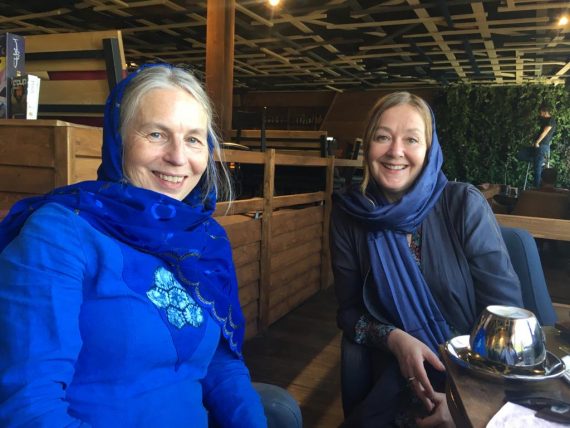
Catrine with Laila in Iran, where they held peace painting workshops for kids of all ages.
CATRINE ON STARTING PAINTING IN WORKSHOPS
We have a method to make them start. For instance. we always use wide brushes in the beginning, and we always have the same size in every board 50 x 70 centimetres, and they are sitting there in front of this quite big board. It’s ‘more easy’ to start. It’s not about the details. It’s about the colours and movements so it’s another way of starting.
CATRINE ON POSITIVE FEELINGS WORKSHOPS
We work with all ages. It can even be children who are two years old and then maybe they have their parents together with them or grandparents. And up to 20 30 years old. It’s very nice to be a mixed group with different ages.
I think it has something to do with the inspiration time we have in the very beginning to make everyone equal.
We focus on the nice things in life. It’s a positive focus.
They also take part in the inspiration time. Which colour do you like just now? Maybe in the evening it may be another colour. Everyone chooses and associates to the colours they choose. Yes. That’s the very beginning. It’s very important for them to take part in the inspiration time and in a way, we get known to each other.
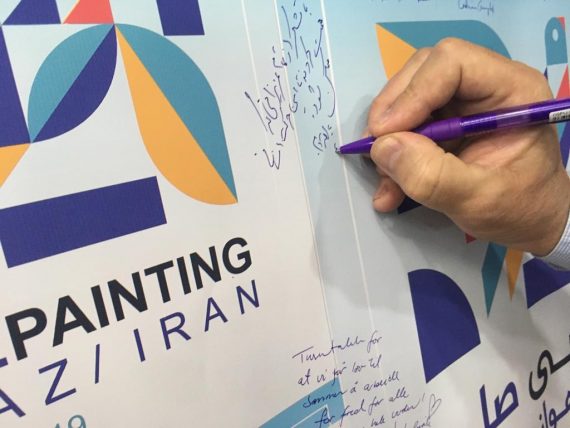
Peacepainting in Iran.
CATRINE ON COLOURS AND MEMORY
We connect the colours to the body in a way.
Colours is visible light. And I always say what can we see when it’s the sun and the rain at the same time and then everyone says the rainbow. And I talk about in our bodies, we have a lot of water up to the shoulders……. In my head I imagine that we have a it becomes a lot of beautiful rainbows in our bodies this just like raindrops increase when it has been raining and the sun is coming and making a lot of diamonds in the trees.
And then we can talk about seven human needs. Everyone has and we connect it to colours. And to the body. Then everyone feels relaxing because we feel equal, and after this session we started, they started to give from their own life experiences, when they start choosing colours one by one.
So for instance one child can choose a colour. And then I say. “Oh, what do you associate with this colour today” and the child says “it this colour it reminds me about A trousers my grandfather used to use and I can see my grandfather is not alive any longer.”
So, you see it’s very personal what they come out with. So when everyone has given an association to the colour they choose. We have quite often we have been through all the human rights in a way.
It’s a kind of de- focused communication.
Yeah it becomes a very good atmosphere.
CATRINE ON HOW MANY PEOPLE?
10 is the best number. That is the very best. Quite often we need one to translate. It goes very well it’s not the big thing, because we are in this abstract language.
CATRINE ON CHILDREN’S MESSAGES
We have been Refugee camps in Lebanon, and we have had workshops, in other countries with children who lost all their relatives in war. And we can see that children who has this terrible experience in losing or their relatives in war, or some people who were close to them. They are really really wanted their painting to go out in the world. So we bring their painting out in the world and making exhibitions. So, the children and the youth can have the feeling that their messages are being heard in a democracy.
People who are taking big decisions that influence on a lot of people need to hear from children and youth. It’s a good inspiration for children and youth.
I remember one painting it was a really big flower and the earth was….full of zig zag – very hard. And the painting was called “to rise from the darkness” so it was it was really easy to see that the children really wanted to look forward to the future.
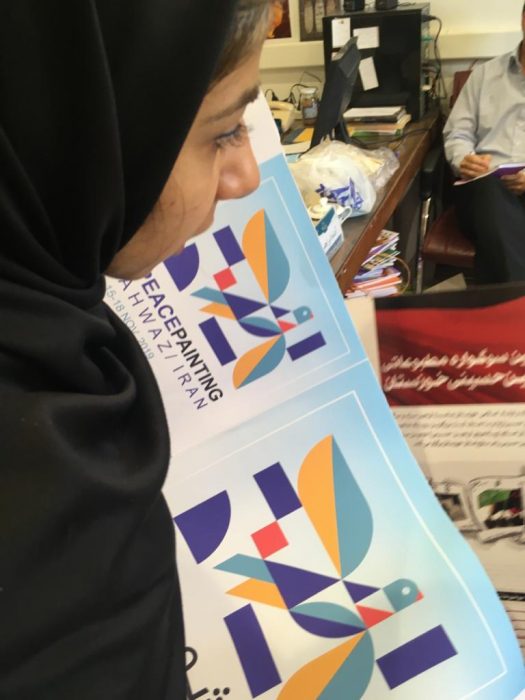
Peace Painting workshop in Iran, 2019
CATRINE ON DE-FOCUSSED THERAPY
It’s a kind of therapy, but we do not focus on it. Every time a painting is painted. It is a mirror.
And they are sharing what they have inside to the rest of the world, and they feel that “I have something important inside” that that people really appreciate.
So that is the environment we are making the workshop.
AMBIENT SOUND: 3. Kids-playing outside.wav
Art is a very good subject to use as a tool.
What if equality could be the normal way in acting and forming systems on the earth? It would be so interesting to see what would happen with um Ecology with Nature, with the wars and so on.
It’s so amazing to see who a like people are all over the world, and what they want to describe, which message they want to give it to each other.
We have been in a lot of different countries and cultures. Tunisia, Lebanon, North Korea, Philippines, and Sri Lanka. Poland, Russia, Portugal, Bulgaria, Finland.
It’s very alike, all over the world.
9.07.
SOUND BRIDGE TO LAILA
—————————————————————
LAILA INTRO
Well my my name is Laila, last year. I’m an artist and I live in Finnmark, Northern Norway, in a little village outside Alta,. [00:04:51][9.7]
ON ALTA CITY PARK
I am working with the Alta city centre making an ice park at the moment.
I involve a lot of people in the projects like schoolchildren. 16 years old, everybody in Alta at that age make an ice sculpture. From the transport they move the ice, and then the builders build with the ice, and then professional artists and then, friends and sculptors from Russia come in to the project, and there are volunteers, there are people, who call me.
There is an architect office, all of a sudden is just growing and growing and growing, and what we’re doing is we are actually creating a park where you can spend time out of doors.
Little by little winter tourism has become very important. So, now there are tourists come along, they also sometimes ask if they can help and they participate.
And so it’s like this become this kind of meeting point, the whole park, of lots of people, and we start already working outside in January, and it’s finished in 7th of March.
And it is sort of growing and sometimes I don’t even know how many people are working there. So it’s interesting. But the main thing when I started the project was I think Alta should be a nicer place. The winter is really long and I used to really hate living here because it was so cold.
DIEGO ICE SOUNDS
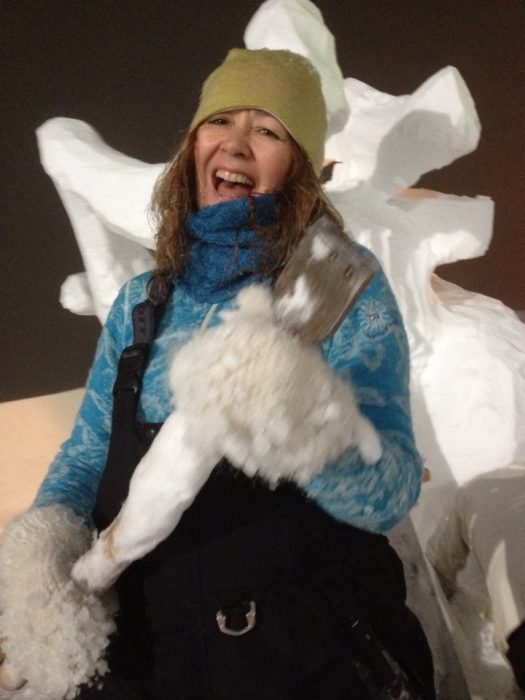 ON ALTA END OF EUROPE
ON ALTA END OF EUROPE
Alta has two months of polar nights from from November until end of January. It is really dark with no sunshine. And we are five hundred kilometers approximately above the Arctic Circle, and Alta is situated by the fjord, not far from the Arctic Sea from the Barent Sea so it’s quite far north. And this 3 hours drive and you end up at North Cape.
So that’s the end of Europe. So you can’t get further north in Europe.
DIEGO ICE SOUNDS
Yeah So that’s where I live. You know sort of on the edge of Europe really cold
Laila On Play
When I was a child I loved being outside. I just. And I was never too cold because of course you have lots of sensible clothes on. So you just enjoy being out of doors. And snow and ice have for an artist and for a child has enormous potential for play and for fun.
You know you can create and you can build really fast, really big, or you can create little things and you can do what you want and you’re using your body all the time you are working so you get tired, but then you start again you rest a little bit and then it’s like, um,I don’t know. It’s really fun. People ask Why are you doing it? Why are you working like this? You are a grown up woman. Playing in the snow.
That’s the only way I can live here actually!
On not liking the cold.
You know I left Alta because just because I hated the cold, I went to Paris when I was 19, Working as an au pair in a family. It took me twelve years before I came back to Alta to live here.
Yeah first I was living in England. A little bit in in Holland, in Hungary, In Oslo, I was living in Bergen, and then I went to Lofoten and so little by little I returned to the north. But I was really really dreading the cold winter and the only thing I was thinking was I was longing to go away. And what can I do inside?
And then somebody asked me “Would you like to participate in an ice sculpting workshop?” And I said No, no I’m an artist, you know Ice is not a serious material for an artist.
Then I went anyway. And then they gave me this kind of really thick clothes like children wear, you know like a whole suit. Now really thick and big. And we went to this lake and there were people from the Ice Hotel in Sweden doing this ice course.
And they gave me this tool, really sharp tool.
And then there was the ice and then I just remember the first the sound of cutting into the ice. This “shhh” it was just amazing. It was just like hooked immediately because this has it’s such a nice feeling of just the movement of with a sharp tool into the ice.
And then all of a sudden ice transformed, it became really interesting.
ON THE MATERIAL OF ICE
I started to look at it differently, I thought you know it was first of all it’s interesting as a material because you could see on both sides. At the same time all the environment around it is reflected into the ice. So if you put an ice sculpture outside then all Nature is reflected into it.
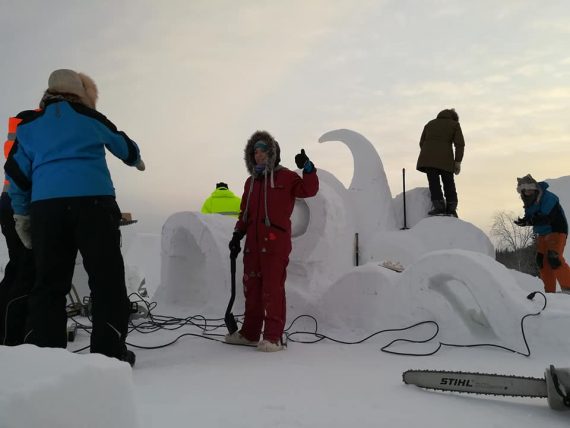
Sculpting snow
And then when I was working more with ice I was started to reflect on the fact that it is water. You know it’s life. I am 70 percent water. This is hundred percent water. So it is only 30 percent difference between this block of ice and me. And every life is dependent on water.
So… So it came in a way from being a material that I didn’t take seriously it became a material that I don’t think there is any material as interesting for an artist.
And then the changes all the time with temperature lit… Slight changing time in change in the temperature. And it goes from ice to water, from and it’s all the time. From being concrete form to vapor, you know.
That’s why you when you put things in a deep freeze and you have to cover it cover it otherwise it dries out. So ice is drying out all this time, it disappears in front of your eyes.
Ice from Nature
In Alta we are so fortunate that it’s so cold that we go to a lake, and we take out the ice from the lake. So we don’t have to produce it. I mean the nature is producing it for us. [00:13:32][11.2]
The way the ice look like it. It depends on the temperature, that winter or that month. Before you take it out you can take it out when this really is day and night or leave it until the March is it up thicker and you can even take care of the ice so that it will grow thicker, and you can take off the snow that protects the ice. And then if you don’t take away the snow then the snow can push down the ice into the water and the water will come up and will form white ice on top.
So you’ve got two qualities of ice. Ice is all the time moving because there are forces, big forces is ice when it’s created. So there are cracks there are bubbles that little fish, even you could find leaves, and dog shit, whatever.
The water is never the same. You can take it out from a river.
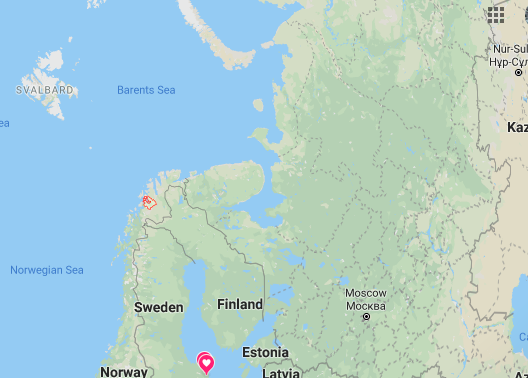
The North
1000 YEARS BACK
And then when you take the ice out then you can look at it and you can see Ah it’s been a cold winter or it’s been a mild winter and then you will see that’s yeah.
You Can see that. And then that’s how they can read. You know in Greenland when they drill big holes or in the Antarctic, to to do research, on one winter, you know. So we got one winter and we create from one winter. But they they have you know they can see 1000 years back and see how the climate the temperature and they can measure it. So it’s interest… So there are stories in the ice, you know.
Temperature
I check the temperature every day several times a day. What kind of weather would it be and what I look at is is not if it’s windy or snowing or is it above or is it below minus. I don’t want to see the red. I don’t want it to be warm in the winter.
So because it means as an artist because it since we are working outside that our things that melting so that we have to try to protect it or whatever. And I can remember my childhood in March. Maybe I’m wrong but this is kind of memory I have that it used to be minus 10 during the day and minus 20 during the night.
This is sort of my memory and we didn’t. I remember because it wasn’t until end of March we would go up into the mountain, go skiing because it would be too cold to go skiing very far. So we will stay. Not so far from the house. And every single weekend I used to go skiing with my parents in the mountains. But we didn’t do that. We didn’t do that in March because March was too cold. And then now when I look, you know March is sometimes you have 8 degrees you can have like a warm spell in February. Eight degrees, really really really warm, maybe for a week sometimes, but not every year is like that. But that’s sort of the occasional year. And I can’t remember that from before you know.
And since I’m working with ice I’m really really sensitive all the time you know how what what is the weather like tomorrow.
DIEGO SOUNDS WARMING
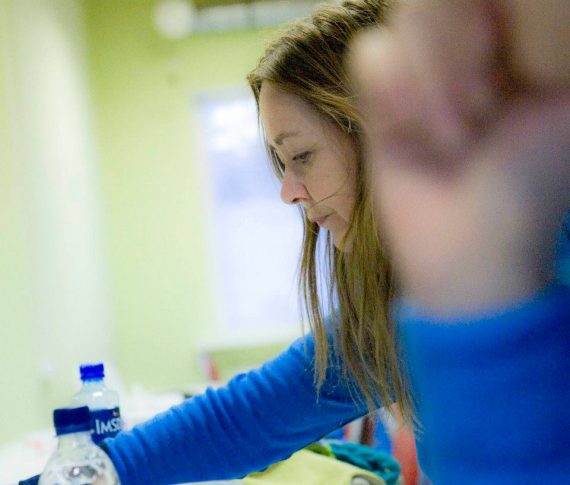
In Kirovsk, Orenburgskaya Oblast’, Russia.
LAILA: [00:18:26] What I can see is that you’ve got trees growing higher up. Little by little there are new trees coming higher up right there before there were just mountains and rocks. So you can see trees are growing faster and higher. So it is getting warmer. It is getting warm. You can see that. [00:18:42][15.7]
ON PREVIOUS PROJECTS
9.00. As an ice artist, I remember when I really really took it it was actually when I brought 15 tons of ice to Copenhagen, in 2004. That was supposed to be the coldest week in Copenhagen. You know they used to have cold winters in Copenhagen before. [00:19:02][4.9]
So we would do this ice project doing Sami manifestations of Sami artists in Copenhagen. So we created it but it was so hot it was so hot the whole time. And it was like 12 degrees and just that night until the morning the wind has changed and shaped the ice and it was just disappearing but at the same time it was really beautiful. So then I started to interest in melting ice. You know what is happening to the ice that is melting. ´
And then I got into reading about the Tundra and I did a project for a festival outside Paris where I brought twelve tons of ice to Paris. It was next to Paris, to a city called Lime. And I made an ice circle of twelve tons of ice.
It was six metre diameter, and then put earth on top, and grass on top and it was melting.
Even it. It was 24 degrees on the opening night. It took like a month to to melt. And then a year after when I came back I could see the change of the different grass that was growing up.
Because the grass that we had left on top people would be stealing. You know so. So. And so when the ice was gone people took the grass and brought it back to the back gardens. And it was like a year after. There was a circle of new grass.
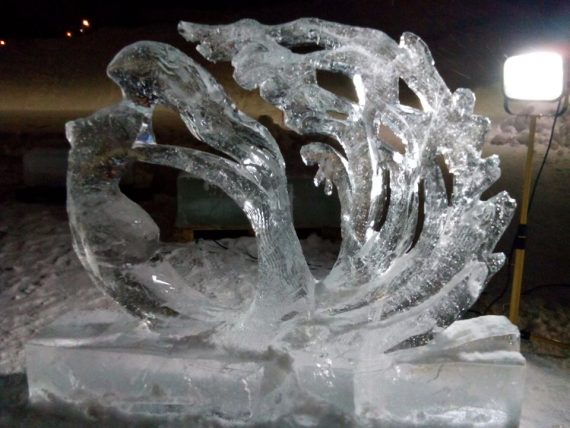
Sculpture from Crazy Saw Ice sculpting competition. Team- the Ice Queens!
Laila on how she started.
My first year I was doing ice sculpture, with just one star made of ice. I just remember I made a star. And that was my first ice sculpture. At the time because I just moved back to Alta, I didn’t have a studio. And I wish I had a studio, and I had all these plans in my head. I need to build a studio, you know. When everybody else had left the lake, I took the last block of ice, and I carried it back to my car, it was quite a big block of ice and drove home. And then I took my shovel and then I shovelled outside in a big heap a snow. And then I put on some lights. I put this block of ice, I put on the radio, and I said I got my studio, but a studio outside.
I don’t need to build a studio. I already got a studio outside.
DON’T LIKE THE COLD continued
All of a sudden I realised that it wasn’t the cold I was hating. I really liked the cold. I didn’t like ‘being’ cold. It’s really simple you know because that’s what people don’t like. They don’t like being cold. But if you is it’s it’s the clothing that’s important that you have good shoes you covered with wool underneath and you have proper clothes and then and then you are free when you’re outside. You can sit down on the ground, you can lie in the snow, or you can do whatever you want, you can sit on the terrace and have a glass of wine, you don’t have to sit inside, you can look at the stars and the Northern Lights or whatever.
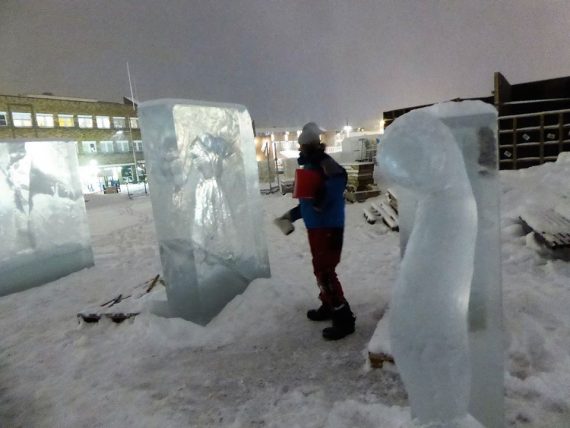
There is always light!
THERE IS LIGHT continued
I remember I came back from Paris just before Christmas and my son came to get me at the airport. Well when I said to him driving through the snow covered landscape and there were stars and a little Northern Lights and God it’s light, it’s really really light, and he said “Mom it’s not like it’s dark.” There is no sun. It’s dark. And I said No no you compare compared to anywhere in Europe now it is really dark. It’s really dark. It’s black because all snow makes it light. You can see the landscape even when it’s dark.
This reminds me of my grandmother and I used to go into her house when I was little and she would sit in the darkness complete darkness, during the dark period. You know the polar night period and I wouldn’t. I would ask my grandmother why are you sitting here in the darkness and he said. Come come have a look. If when I’m in the darkness I can see the little light outside.
And if I put on the light I don’t see anything.
The snow and ice project, it gives sort of an identity to the young people, so that now everybody expects that when they are in 16 years old they’re supposed to do an ice sculpting course, one that the high school building department Transport Department they all enjoy and the art department they all take part, in this creating of the festival As long as well as professionals.
THIS YEAR- THE RIVER & ALTA AKTION
And this year we are doing a project about the river. Elva and that’s because this year it is the year of the wild salmon.
And then I thought that would be good to focus on the river, you know. The river is all cultures, you know agriculture, people’s lives are from the river. So we are making a big river going through the park full of live from from the mountain plateau. Until the fuel within the fjord will be an ice skating rink and it is also voyage from the Sami drum, until the fight, for the Alta river, Alta Aktion that was here in the 70s, ‘80s.
For five years there was this big battle against building out the river. Eventually they lost but the sound we gained. Well we as a Sami we gained our Parliament Sami Parliament.
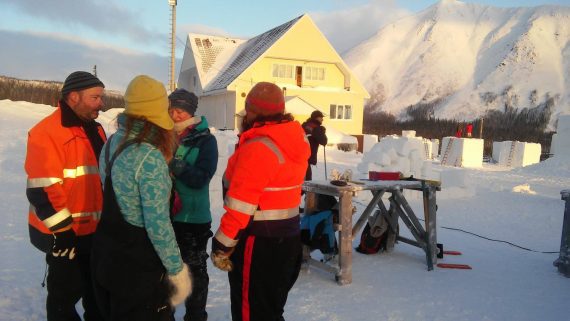
Laila with her colleagues with Elisabeth Kristensen and Mari Charlotte Bottolfsen in Kirovsk, Murmanskaya Oblast’, Russia.
2019-2020 The river project and copper mining
The Norwegian government just decided to put a lot of waste from our copper mine decided to give permission to copper mining company can put it in the field not so far from here yeah. A copper mine in it up of yours. And then you think. How is it possible today with all the knowledge that we have. Do we need this copper so badly that we cannot think where to put the waste? Even if it’s a bit more expensive.
I think this river project that we’re doing, maybe people will think well it’s it’s still an issue, because we’re dealing with the environmental battle from the river of Alta. And this happened when I was young and you know so my father he was working for the environmental organisation. He brought me to do all these demonstrations and manifestations against building out the river. ALTA AKTIONEN no you should read it.
DIEGO SOUND
Life is diversity!
In Alta. There is a tradition for having a big market twice a year in do in November and in March exactly when the festival is so traditionally the Sami would come from the mountains.
To sell their stuff and the Russians would come and we would all meet and we. And now today is exactly the same. A lot of people from Russia come to sell their products and there are the Sami people selling their handicrafts or local produce, and making teas, or meat, or Thai people making making.
And there there is a guy in the van. He’s selling kebab. And I think he’s from Syria. After the meeting of the Samis, the Norwegian and then the Kvan, the Finnish people. So it’s a meeting on. The basis of the local people here are are a mix of people. We had a really long time ago. No now we got people I don’t know from 40 different nations living in Alta.
The identity of a place
When I talk about identity for me what’s interesting is is what happens now, that we can we can share and we share. We share the cold, you know doesn’t matter what kind where your father came from. If you live here it is cold, and You have to deal with the cold.
——————————————
Neighbours.
15.40 We also have been working a lot with Russian artists and this year. We also will have Russian students coming from the Arts School on Murmansk. So it’s really I’m really happy for that because in a time when when you are not so you we are all the time looking for faults. And how we cannot cooperate. I think it’s even more important for artists and people to actually to connect and try to still work
We have to to create a better future. It’s not possible to close your eyes to your neighbour. Not Possible.
The basis of what we are doing is actually. You know it’s cold. So if it’s if it gets warmer we can’t do this. snow and Ice thing. And it’s really strange because when I was young tourists came to visit the north to see the midnight sun came here. So that was not. There were no tourists at all in the winter period. And now it’s upside down. Because of that I think it is because of the climate change. All of a sudden people are interested in the cold because Europe doesn’t have any long winters anymore. So people come here and and discover that yeah.
We need to take care of the cold.
And for the local people it’s actually a resource, it’s it’s a part of our identity. You know imagine if we didn’t have any winter you know what would we do without the winter before we used to think what we do when we have the winter you know. So it’s it’s turned upside down.
I think the period when you see the most people are out of doors and spending time in the centre is actually during the festival, when we are making snow and ice out when it’s the dog sled race. So it’s one of the year time of the year when we build up everything that there are really a feeling of life. And things are happening otherwise I think it’s quite dead.
Because people staying indoors
20.54
On teaching kids
The most important work is actually you know like the teachers are doing. Or artists working we teach kids you know. That’s the the work that hasn’t got any recognition you know.
So if you are an artist and doing paintings and only thinking about yourself and put them in galleries, then you are a great artist, but if you work with kids, or you work with snow and ice or whatever then then then it doesn’t happen in that way. You see. And therefore I think a lot of artists would avoid exactly working as I do and the kids they’re just there, you know what I think is really really important for any artist to consider where they are, you know and be a part of where they are. I think that’s it’s like it’s like a duty. I feel I have a duty to give back what I’ve been given.
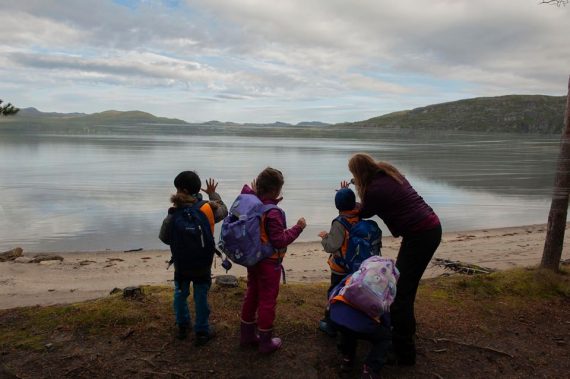
Outside with kids exploring nature
DIEGO SOUND
PLACE IDENTITY – ALTA AND STRANGERS
You know why do I do it? Yeah, I know the reason: I want Alta to be a better place than it was when I was growing up, that’s why I do this, because it’s it has been a very closed place. You you are skeptical to strangers you you’re not supposed to talk to strangers, and all that, and you and I always saw strangers it was the most interesting thing of all!
You know people who didn’t know what they were thinking and they were looking different and they were eating different food. I think all that’s interesting. It makes your life much more rich you know. So I think there’s not enough different people were not allowed to be as different as we are but at the same time we are being different. We are the same.
I really liked the fact that you don’t know who said that a stranger is only a friend that you don’t know yet.
If I was really realistic I wouldn’t let any of what I’m doing who would work with snow and ice and who would work with kids. Kids! You cannot be environmentalist and not think about people not think about the kids.
I think artist and doing art with children is quite important. And then doing it in a way that it resembles Play.
Land Art with children
In the autumn what I did is land art project with kids that were they were seven years old and every day there would be a class coming to the beach area in autumn. There is a beach and a forest is really beautiful. With lots of old pine trees.
And it was quite interesting to see because I have been in France and seen the little children going to the kindergarten, and then where they are in little squares with concrete and they play out and they are dressed like little women and little with skirts and short trousers, also like that in England.
And then you see this little Norwegian children. I think that made me really proud, because they are really sensible dressed, with high boots and and suits to sit on the ground, and they all prepared a little packed lunch, sausages, and they stay outside maybe even if it’s really really cold like it was minus 4 degrees or wind, , sleet and they didn’t complain, you know? They were just getting on with it and then they were grilling our sausages on the bonfire and they had all the equipment that they needed and they were all prepared and they were all really happy being outside.
So I think the kindergarten and teachers in this in the younger age in school are doing a great job with the kids being outside.
Actually I’ve I’ve read that that French kindergartens and and I come and are coming to visit Kindergardens in Norway, just to see how we actually manage to have kids being outside. I mean there are kindergartens and even here in the Arctic there are almost all the time out of doors, almost all day.
——————————
DIEGO SOUND KIDS PLAYING OUTSIDE
STORY OF THE BIRD.
LAILA: We had like a kickoff for the project at the high school with all the builders and the people from the Transport Department….
We invited the historian, to come and talk a little bit about the history of the river so that there were all everybody will have like a little rucksack with information, and and then he was telling me about something I didn’t know, that there is exists Alta. Is this the name of the town now. And the part where I come from it was called Elvabacken, and that it existed an even older name that was called Sortcots, and it’s the name of a bird in Norwegian its called Svennesnipa, so it goes is the name of a bird.
It is a bird that migrates. It migrates to the tropics from from from Lapland. And you don’t find this bird in southern Norway or in southern Scandinavia, so it migrates between Lapland and the tropics. And and it’s the woman that is the beauty of it has the nice feathers and she lays the eggs and she leaves the upbringing to the male bird, and she is really bossy, and she is if somebody is attacking, Then she is the one who defends him and the kids. But in the end she leaves and she goes off to the tropics again and she leaves them all the work with him.
And she also has several partners.
So it’s a world where it’s upside down. So it’s a little bit. So I just thought it was really funny that this bird has given the name to the place where I come from.
22.42
—————————————————————
CREDITS
DIEGO SOUND: TANYA SUMMER GARDEN
TANYA’S VOICE:
Thank you for listening to this episode of Nordic By Nature, ON ART.
You can find more info on our guests and a transcript of this podcast on imaginarylife.net/podcast.
Catrine Gangsto’s website is peacepainting.org.
You can find Laila Kolostyák on Facebook, through the website, icecircle.info and her own website, lailakolostyák.com. That is (spells it)
Nordic by Nature is an ImaginaryLife production. We are also fundraising on panteon.com/nordicbynature. Please help us by sharing a link to this episode with the hashtag #tracesofnorth and follow us on Instagram @nordicbynaturepodcast.
The music and sound has been arranged by Diego Losa. You can find Diego through his website diegolosa.blogspot.com.
You can read more about Ajay Rasogi’s nature-centered mindfulness and the village homestays on foundnature.org. You also can follow the Foundation for the Contemplation of Nature on Facebook, and Contemplation of Nature on Instagram.
We’d love to hear your thoughts on our podcast. So please don’t hesitate to email me, Tanya, on nordicbynature@gmail.com
END
